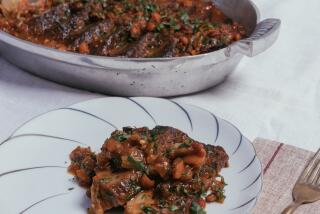Brisket Basics
- Share via
What is a brisket, exactly? The brisket is a boneless roast that comes from the chest of the steer right next to the foreleg.
You do not have to be Jewish to enjoy brisket--it’s simply a specific cut of beef--but if you have trouble finding one in your supermarket, try a kosher butcher. When you’re shopping, you may be tempted by a small brisket, but remember that larger ones roast better. Look for a 6- to 7-pound one and freeze the leftovers.
Brisket comes as two connected pieces, but in the store you’ll rarely find them together. Instead, they’ll be sold as either first or second cut. Second cut, which comes from the top part of the brisket, is somewhat fattier but makes a better roast. First cut is rather lean and a little less flavorful after the long braising that brisket thrives on.
Brisket is a rather sinewy roast, suited to long braising and tons of flavorings. It is traditionally slow-roasted or braised, cooled, then sliced and braised again in its pan juices.
Because brisket is so sinewy, it must be cut across the grain to be tender.
Brisket can make for hard-to-clean roasting pans. It is a good idea to line the bottom of the pan with heavy-duty foil to make cleanup (and catching all those pan juices) easier.
More to Read
Eat your way across L.A.
Get our weekly Tasting Notes newsletter for reviews, news and more.
You may occasionally receive promotional content from the Los Angeles Times.









